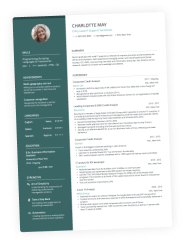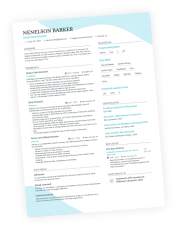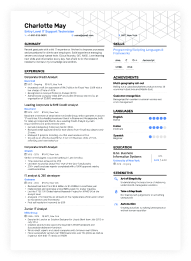It’s frustrating when your resume no longer opens doors—you have the experience, but employers aren’t calling.
For mid-career professionals, the challenge is crafting a resume that shows growth and impact—without sounding outdated or overloaded.
At this stage, not every job you've held still matters. You need a resume that reflects where you’re going, not just where you’ve been.
Whether you're aiming for a promotion, switching fields, or re-entering the workforce, hiring managers want to see clear progression, measurable results, and relevant skills.
This guide will show you how to build a modern, effective mid-career resume—with expert strategies, formatting tips, and real-world examples to make you shine.
Key takeaways
- Keep your resume to two pages and focus on recent, relevant experience.
- Use a professional summary instead of a career objective.
- Quantify achievements with metrics that show your impact.
- Tailor your resume for each job using keywords from the job description.
- Use a clean, ATS-friendly format—avoid graphics or complex layouts.
- Highlight core competencies and transferable skills clearly.
Before you apply, make sure your resume can pass modern applicant tracking systems (ATS). Upload your resume now to get a free ATS check.
Is your resume good enough?
Drop your resume here or choose a file. PDF & DOCX only. Max 2MB file size.
Understanding the mid-career resume
A mid-career resume is for professionals who’ve moved past entry-level work—typically with five to ten years of experience—and are ready for what’s next. That might mean moving up, switching tracks, or getting back in after some time away. Whatever the goal, your resume needs to reflect growth, focus, and readiness for the next step.
At this stage of your career, your resume needs to work harder—and smarter. Recruiters don’t want a full autobiography. They want a sharp, relevant story that makes it easy to say, “This person fits.”
The challenge? You've likely held multiple roles, worn many hats, and seen measurable success. But not all of it belongs on the page. This guide will help you make strategic choices: what to keep, what to trim, and how to format your experience to get noticed.
Let’s start with the basics:
How long should it be?
A two-page resume is the standard for mid-career professionals. It provides enough space to showcase your most valuable experience without overwhelming hiring managers.
Exceptions:
If you're in academia, research, or a highly technical field requiring a CV, a longer document may be acceptable.
Should you include older jobs?
Yes, but only if they’re relevant to the job you’re applying for. For positions older than 10–15 years, list only the job title, company, and years worked. Focus mainly on your most recent and impactful experience.
How to balance depth and brevity
- Prioritize recent, relevant roles and cut information that no longer adds value.
- Quantify achievements (e.g., “Increased efficiency by 30%” instead of “Managed a team”).
- Remove fluff like generic soft skills or outdated software knowledge.
- Use bullet points to keep your experience easy to scan.
A strategic, streamlined resume ensures that recruiters quickly see your qualifications without getting lost in unnecessary details.
Mid-Career Resume Trends
According to Enhancv's latest resume statistics, mid-level professionals made up 50% of all users creating resumes in 2024. Their resumes are becoming more detailed, with word counts rising to an average of 610 words and most including at least five job entries. This is a sign that candidates are emphasizing career growth and accomplishments more than ever.
How to write a mid-career resume
A mid-career resume should be structured to highlight your experience, impact, and industry expertise while keeping it concise and easy to scan. Each section should be tailored to emphasize your career growth, leadership skills, and relevant achievements.
Below are the key components every mid-career resume needs.
Professional summary
Your professional summary is your elevator pitch—three to four sentences at the top of your resume that quickly convey who you are, what you bring to the table, and your biggest strengths.
How to write a strong professional summary:
- Start with your job title and years of experience.
- Mention your industry expertise and key qualifications.
- Highlight leadership, problem-solving, or process improvements.
- Use metrics to provide evidence of your skills and accomplishments.
Should you use a professional objective
A professional objective can help explain a transition—but it's not for everyone. It’s typically shorter and more common for entry-level candidates, which doesn’t apply to you. Instead of an objective, use your summary to highlight your current circumstances, especially if you’re:
- Changing industries and need to clarify your direction.
- Re-entering the workforce after a career break.
- Pivoting roles within the same industry (e.g., moving from sales to operations).
Good example for a career changer:
This kind of statement provides clarity for both human readers and applicant tracking systems, especially when your experience doesn’t align 1:1 with the roles you're pursuing.
Optimize your resume summary and objective for ATS
Drop your resume here or choose a file.
PDF & DOCX only. Max 2MB file size.
Core competencies
A core competencies section helps your resume pass AI scanners and quickly communicates your top skills to recruiters.
How to structure this section:
- List six to ten key skills in bullet or column format.
- Use industry-relevant keywords from job descriptions.
- Include a mix of technical and leadership skills.
Suggested skill categories:
- Technical Skills: Data analysis, coding languages, process optimization.
- Leadership Skills: Team management, strategic planning, change management.
- Industry-Specific Expertise: Compliance (for finance/legal), SEO (for marketing), Agile methodologies (for IT).
Here’s how a marketer used Enhancv’s resume builder to create their core competencies section:
If you’re using MS Word to build your resume, you can list your key qualifications right after the profile section, separating them with a vertical bar (|).
For example, an accountant might write:
Financial Reporting & Analysis | Budgeting & Forecasting | Tax Preparation & Compliance | Auditing & Risk Management | GAAP & IFRS Standards
Professional experience
The work experience section is where you prove your impact by showing quantifiable achievements instead of just listing responsibilities.
How to write effective bullet points:
Formula: Action verb + task + result
- •Revamped digital advertising strategy, increasing lead conversions by 35% in six months.
- •Led a team of 10 sales reps, achieving a 20% increase in quarterly revenue.
- •Implemented a new inventory tracking system, reducing stock discrepancies by 40%.
In this section, try to avoid:
- Basic job duties (focus on accomplishments instead).
- Jargon and outdated tools (e.g., listing Microsoft Word as a skill).
- Experience from 10+ years ago (unless highly relevant).
How to handle career changes or employment gaps:
- If you switched industries, highlight transferable skills.
- If you had a career break, mention freelance work, certifications, or volunteer projects that kept your skills sharp.
A career change—or even time away from work—won’t raise red flags if your resume shows how you used that time to build new skills or stay sharp.
Education and certifications
Your education section shows that you meet baseline qualifications and demonstrates a commitment to your field.
At the mid-career level, your work experience often matters more, so your educational background typically goes at the end of your resume.
However, your degrees, certifications, and ongoing training still play a vital role—especially if they align with the roles you’re targeting.
If you're pursuing a new credential or degree, it's helpful to mention it along with your expected completion date to underline career progression.
Should you list graduation years?
- Yes: If you’ve graduated within the last ten years.
- No: If your degree is older than ten years (to avoid age bias).
How to highlight continuing education:
- List relevant certifications, workshops, and online courses.
- Focus on leadership or industry-specific training (e.g., PMP, Six Sigma, Google Analytics).
- Include the expected completion date to emphasize your commitment.
Here’s what a well-written education entry might look like for a mid-career professional pursuing leadership or strategy roles:
Education
MBA, Marketing & Strategy
University of California, Los Angeles (UCLA)
Graduated: 2018
- Focused on brand management, strategic planning, and go-to-market execution.
- Completed coursework in Consumer Behavior, Data-Driven Marketing, and Competitive Strategy.
- Participated in a capstone project advising a Fortune 500 company on digital product expansion.
Certifications
- Certified Scrum Master (CSM) – Scrum Alliance, 2023
- Google Analytics Certification – Google, 2022
- HubSpot Inbound Marketing Certification – HubSpot Academy, 2021
Additional sections that matter
These additional resume sections are optional but can help strengthen your resume:
- Add this section if you’re a member of respected industry organizations or have taken part in conferences, committees, or speaking engagements.
- Example: Membership in PMI, AMA, or SHRM; speaker at a regional industry event.
- Include volunteer experience if it shows leadership, industry-related skills, or active community involvement that reflects well on your character or capabilities.
- Example: Led a fundraising initiative that generated $50K for a nonprofit.
- Add this section if you've written articles, white papers, or industry blog posts—especially if they were published by reputable sources or relate directly to your target role. This can demonstrate thought leadership and subject matter expertise.
- Example: Contributed an article on digital campaign analytics to MarketingProfs; featured in HubSpot’s industry trends newsletter.
Only include these sections if they genuinely strengthen your application and align with the position you’re targeting. If it doesn’t support your fit for the role, leave it out.
Formatting a mid-career resume
A clean, well-structured resume is essential to making a strong first impression. Messy formatting and common mistakes can cause your resume to be overlooked, even if you have the right experience.
Follow these best practices to ensure your resume is professional, ATS-friendly, and impactful.
Choosing the right resume format
Your resume’s layout plays a key role in how easily recruiters and ATS systems can process it. A clean format assuresyour most important qualifications are seen right away.
For mid-level job seekers, the reverse chronological format is typically the best choice. It highlights your career progression and recent accomplishments first—making it easy for hiring managers to understand your trajectory and impact at a glance.
Formatting tips to follow
- Use a modern, professional layout with clear section headings.
- Stick to easy-to-read fonts like Calibri, Arial, Rubik, or Garamond (10–12pt size).
- Keep one-inch margins and use enough white space for readability.
- Use bullet points for clarity and avoid long paragraphs.
- Skip graphics, tables, or images—these can confuse ATS parsing.
PDF vs. Word Document: Which one to use?
How you save and submit your resume matters. Some formats display better across devices, while others are better for making it through ATS.
Best file format for submitting your resume
| File type | When to use it |
|---|---|
| Use this if the job posting doesn’t specify a format. PDFs preserve your formatting across all devices and are safe for most ATS systems. | |
| Word (.docx) | Use this if the job posting specifically asks for a Word file. Some older ATS systems process .docx files more reliably than PDFs. |
| Google Docs | Avoid sending links. If you’re using Google Docs to create your resume, always download it as a PDF or Word file before submitting. |
Before submitting, name your resume file professionally—use a format like “FirstName_LastName_Resume.pdf” to make it easy for recruiters to find and identify your document. Avoid vague names like “MyResume_Final2.pdf.”
Common resume mistakes to avoid
Even professionals with 10+ years of experience make avoidable resume mistakes.
Here are the most common pitfalls and how to fix them:
- Using a career objective instead of a summary:Career objectives can work for junior candidates with little experience who want to show direction. But mid-career professionals are better off with a summary—it focuses on how your expertise meets the company’s needs.
- Too much detail on early jobs: Jobs from 10–15 years ago should be summarized, not thoroughly explained. Focus on recent, relevant experience.
- Listing responsibilities instead of achievements: Recruiters want “impact,” not just job descriptions—use quantifiable results.
- Leaving out key skills because they seem “obvious”: If a skill appears in the job description and you have it, list it—especially technical or leadership skills—to ensure your resume passes ATS filters.
- Overstuffing with text: White space improves readability. Keep descriptions concise and impactful. If you don’t want to fuss over formatting, Enhancv’s resume templates can help you keep things clean and well-structured.
Optimization tips for a more effective mid-level resume
To increase your chances of landing interviews, you’ll need to fine-tune your resume beyond the basics.
Quick optimization checklist for mid-level resumes
- Tailor your resume for each job application: Use keywords from the job description.
- Align your LinkedIn profile with your resume: Match job titles, dates, and key messaging to ensure consistency across both platforms.
- Test your resume with an ATS checker: Do that before submitting it to check if it’s formatted correctly.
These small adjustments can improve your visibility, credibility, and compatibility with both recruiters and applicant tracking systems.
Stronger action verbs for impact
Replace weak words like "managed" or "helped" with powerful, results-oriented verbs:
- Led → Directed, Spearheaded
- Improved → Enhanced, Streamlined
- Created → Developed, Implemented
- Increased → Boosted, Expanded
By following these formatting and content guidelines, your mid-career resume will be polished, professional, and primed for success.
Case studies with before-and-after resume examples
Now that you know how to structure a strong mid-career resume, let’s look at real-world examples. Below are two common scenarios: an overly cluttered resume and a career pivot. See how small changes can transform an ineffective resume into one that lands interviews.
Case study 1: Transforming a cluttered resume into a concise, impactful one
This example shows how a mid-career professional’s resume can become a liability when it’s overloaded with outdated or irrelevant content. The original version focused on job duties instead of accomplishments, listed every role since graduation, and opened with a generic objective.
By trimming the length, focusing on recent roles, and using a results-driven summary, the revised resume became far more compelling and easier to scan.
Before:
- A mid-career marketing professional had an overly long resume packed with job descriptions rather than achievements.
- Used a career objective instead of a summary statement.
- Listed every single job since college, including irrelevant roles.
Let’s take a closer look at what’s not working in this version.
Isabella Adams
Marketing Professional
(303) 555-0XXX | isabella.adams@enhancv.com | @LinkedIn | Denver, CO
Objective
Motivated marketing professional seeking an opportunity to apply my skills in advertising, social media, and teamwork. Looking for a role that offers growth and development in the marketing field.
Experience
Digital Marketing Manager
Cloud9 Digital Solutions, Denver, CO
January 2022 – Present
- Led marketing campaigns
- Managed ad budgets
- Worked with SEO and Google Ads
- Supervised the marketing team
Senior Marketing Specialist
Dynamik Marketing Agency, Denver, CO
January 2018 – December 2021
- In charge of email marketing
- Did A/B testing
- Collaborated with other departments
- Created reports
Marketing Coordinator
BrightPath Solutions, Denver, CO
June 2015 – December 2017
- Responsible for managing social media accounts
- Helped with marketing events
- Worked on email campaigns
- Assisted team with general office duties
Freelance Blogger
Self-Employed
2014 – 2016
- Wrote lifestyle blog posts
- Shared content on social platforms
Education
Associate of Science in Marketing
Community College of Denver
Graduated: 2015
- Took courses in business, sales, and marketing
- Completed class projects and presentations
- Attended marketing club events on campus
Certifications
- Google Analytics – 2020
- Introduction to SEO – 2019
Skills
- Microsoft Office, Social Media, Blogging, Teamwork
Languages
- English (native)
Why this resume doesn’t work: This resume focuses on tasks, not results. It lacks metrics, uses vague language, and starts with an objective instead of a summary. Overall, it undersells the candidate’s experience and doesn’t position her as a qualified mid-level candidate.
Here’s how the same experience was rewritten to better reflect her value and readiness for the role.
After:
- Reduced to one page with a focus on recent, relevant experience.
- Replaced the objective with a powerful summary highlighting career impact.
- Kept early roles but minimized detail to focus on recent achievements.
- Used metrics: “Increased lead conversion rates by 35% in 6 months.”
Here’s the improved version of her resume—streamlined, modern, and tailored for a digital marketing role using Enhancv’s Resume Builder:
With a clearer, more targeted layout, this resume now emphasizes recent accomplishments and aligns with current job goals.
Case study 2: A career pivoter’s resume makeover
Career changers often struggle with translating past experience into new opportunities. In this case, the original resume leaned too heavily on technical IT language and lacked any indication of readiness for a data analytics role.
Before:
- An IT project manager transitioning into data analytics had a resume filled with IT jargon.
- No data-specific skills or relevant coursework listed.
- Work experience was too technical, without business impact.
Let’s take a closer look at what’s not working in this version.
Samuel Moore
IT Project Manager
(919) 555-0XXX | samuel.moore@enhancv.com | @LinkedIn | Raleigh, NC
Summary
Experienced IT project manager skilled in overseeing technical development projects and managing cross-functional teams. Seeking to leverage infrastructure and systems knowledge in a new role.
Experience
Project Manager
InnovaTech Solutions, Raleigh, NC
April 2020 – Present
- Led IT infrastructure upgrade projects
- Managed timelines and developer teams
- Handled project documentation and stakeholder reporting
- Coordinated vendor relations and deployment schedules
Technical Project Coordinator
CoreLogic Systems, Raleigh, NC
June 2016 – March 2020
- Assisted in managing software implementation plans
- Maintained system documentation
- Scheduled internal QA reviews
- Acted as liaison between business and development teams
Education
Associate of Science in Information Technology
Wake Technical Community College
Graduated: 2015
- Studied computer systems and networking
- Completed group projects on basic IT support
- Attended guest lectures on tech careers
Certifications
- PMP Certification – 2019
- ITIL Foundations – 2018
Skills
- Project Planning, SDLC, Vendor Management, Budget Tracking, Technical Documentation
Languages
- English (native)
Why this resume falls short: This resume focuses too much on IT project management and lacks any clear connection to data analytics. It’s filled with technical terms, offers no relevant tools or coursework, and doesn’t explain the career shift. As a result, it doesn’t position the candidate for the role he’s targeting.
The new version feels like a big shift. Here’s what changed:
After:
- Added a skills section with data analytics tools (SQL, Python, Tableau).
- Used a summary that clearly positioned them for analytics: “IT project manager with 10+ years of experience, now transitioning into data analytics with expertise in SQL and business intelligence.”
- Reframed IT achievements to showcase transferable skills: “Managed projects that improved data reporting accuracy by 40%.”
Take a look at the revised resume—this one does a great job of positioning a project manager for a mid-level data analyst role. Once again, we used Enhancv’s Resume Builder for the improvements:
By reframing technical experience and emphasizing new skills, this resume shows readiness for a successful career transition.
Conclusion
Your mid-career resume isn’t just a list of past jobs—it’s a strategic tool for landing your next opportunity. Whether you’re aiming for a promotion or switching industries, keeping your resume concise, results-driven, and ATS-friendly is key.
Ready to see how your resume stacks up? Upload it now to get instant feedback and expert suggestions.
Is your resume good enough?
Drop your resume here or choose a file. PDF & DOCX only. Max 2MB file size.
Make one that's truly you.





